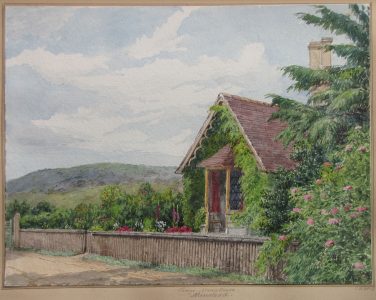2. Charles Burrard
The following contribution was written by New Forest Heritage Centre volunteer Chris Blake.
The grave of ‘Admiral Sir Charles Burrard’ at St Michael & All Angels in Lyndhurst was recently restored by the Napoleonic and Revolutionary War Graves Charity. This is part of an initiative to ensure stories like his are not forgotten. Fortunately, Admiral Sir Charles Burrard and his family preserved their story in sketchbooks, held in the New Forest Heritage Centre.
Charles Burrard was born into a military family in 1793, third in line to inherit the baronetcy of Lymington. He joined the Royal Navy at the age of 11 , in 1805. By 1806 he was aboard HMS London as a Midshipman. This was during the Napoleonic Wars, months after the Battle of Trafalgar. In the morning darkness of the 13th March, French commerce raiders mistook the ships of his squadron for merchantmen. Before the French surrender, 10 men had been killed and 22 wounded aboard HMS London during hours of thunderous gunfire. Burrard later painted this event from a removed third-person viewpoint.
Shortly afterwards, Charles was transferred to HMS Victory. In January 1809, the Victory escorted transport ships to La Coruña, to evacuate British troops following their desperate retreat to the coast of Northern Spain. Charles’ eldest brother was ashore, serving as Aide de Camp to Lieutenant-General Sir John Moore. During the battle to defend the port and the possibility of evacuation, Charles’ brother was killed. It is likely that Charles was in the harbour at the time.
That October, his surviving older brother (also a Midshipman in the Navy) was drowned after his boat capsized near Weymouth. Charles was now unexpectedly first in line to inherit, aged about 16, having lost his older brothers. As the eldest son of a Baronet, he was entitled to a knighthood. Sir Charles was promoted to Lieutenant after three years and served in actions around the Mediterranean.
Sir Charles’ father died in 1813, apparently from a heart broken by the news of his other son’s death at the Siege of San Sebastian. Charles was now 2nd Baronet Lymington.
The following years saw his first commands, and the end of the Napoleonic Wars. He rose through the ranks of the Navy, and was often in the Mediterranean. There he met his future wife, Louisa Lushington, daughter of the British Consul-General in Naples. They married in 1826, returning to England in 1827.
Sir Charles was then pensioned out of the Navy aged 34, as a ‘Superannuated Captain’. A naval officer promoted to Captain was entitled to lifelong promotion in strict order of seniority, regardless of functional demand for higher-ranking officers. Sir Charles Burrard was promoted for the rest of his life, eventually becoming an Admiral.
He spent the rest of his life in and around the New Forest raising a large family, though he was ultimately the last Baronet Lymington. He and his wife likely helped teach their children to paint and draw. They dedicated these decades of peace to the Church, and the creation of an extraordinary painted archive of rural nineteenth century Hampshire.
Sources:
‘The Naval Chronicle for 1809’ (1809), Volume XXI, London : J. Gold, pg. 60-61
https://archive.org/details/navalchronicleco21londiala/page/60/mode/2up?view=theater
Marshall (1823) Royal Naval Biography, pg. 378-379
https://en.wikisource.org/wiki/Royal_Naval_Biography/Burrard,_Charles
NRWGC (2023) Grave Clean: Admiral Sir Charles Burrard,
https://www.nrwgc.com/post/grave-clean-admiral-charles-burrard
O’Brien (1849) A Naval Biographical Dictionary 1849, pg. 149. https://archive.org/details/cu31924027921372/page/148/mode/2up?q=burrard
Pasmore, A. (2019) New Forest Notes March 2019, https://www.newforesthistoryandarchaeology.org.uk/nf_notes/notes_mar19.pdf
Slothlouber, L. (2017) ‘Journal of Louisa Lushington (1821-1822)’, Alton: Chawton House Press
https://nfknowledge.org/record/nfc-159428/


